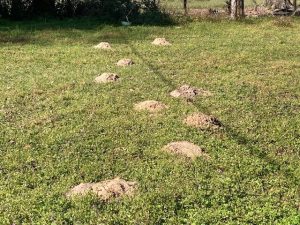On the sixth day of winter,
a dear friend gave to me,
sandy mounds of soil.
What’s making these HUGE piles of dirt? They seem to ‘show up’ overnight.
Turns out the the mystery is linked to an unseen and relatively important ecological engineer. Geomys pinetis is a mammal with large forelimbs and hairless tail. Common names and southern vernacular include pocket gopher, sandy-mounder and salamander. How does this animal create the large mounds of soil? Follow Sarah Duncan, post-doc at University of Florida in this video of the seldom seen Geomys pinetis or southeastern pocket gopher in action.
“…part of our research is to understand the genetics of the southeastern pocket gopher. The southeastern pocket gopher is thought to be declining across its range and is currently listed as threatened in Georgia. We are collecting tissue samples to study the genetic health and connectivity of pocket gopher populations in order to assist with conservation management strategies for the species.” S. Duncan
Pocket gopher prefer deep, well-drained sandy soils.

Sandy soils encourage pocket gopher activity. Tunnels are found two inches to two feet below surface. Pushing soils out of underground tunnels result in above ground mounds. Fresh mounds measure 4-6 inches tall and twelve inches or more in diameter. Aside from mixing and loosening soil, of what value is the pocket gopher? The UF publication ‘Ecological Engineers: Southeastern Pocket Gophers Are One Of Nature’s Architects’, (December 2020) may shed light on its importance.
The mounds are unsightly. What are my options to get rid of pocket gophers?
Trapping is one option. Except when raising young, pocket gopher lead solitary lives. Fresh mounds provide a hint as to tunnel location. Probe between two fresh mounds for best chances of locating the tunnel. Attach macabee trap with wire or twine to above ground stake. Dr. Terry Salmon, University of California, San Diego illustrates macabee trap placement in the video below.
Choker traps – If trap does not kill quickly be prepared to humanely kill the pocket gopher. Adult pocket gopher measure ten inches from tip of nose to tail tip.
Baits are effective. Use products registered for use in Florida. Follow label recommendations.
Natural predators – owls, hawks, coyote and pine snake. Domestic cats and dogs could catch them as well.
Bury galvanized hardware cloth at least 2 feet and extending 6 inches above ground to restrict gopher activity. Vibrating devices, chemical repellents and flooding tunnels with water, in sandy well drained soils, have not been proven effective.

Resources
Duncan encourages participation in iNaturalist pocket gopher project. The information supplements a large-scale surveying effort in cooperation with the University of Georgia, University of Florida, Florida Fish and Wildlife conservation commission, Georgia Department of Natural Resources, Auburn University, and the Joseph W. Jones Ecological Research Center.
Identifying what’s causing mounds, burrows and symptoms of feeding is illustrated and described in UF’s ‘How To Identify The Wildlife Species Responsible For Damage In Your Yard’ (December, 2018) publication. Hope this is of help. Find this helpful? Click the heart. Feel free to comment below. Until next time – Happy Gardening!
 0
0
